Birds with black-colored plumage are one of the prettiest and most elegant in the world.
Some might consider them to be a bad omen, but their charm and elegance can’t be denied.
Examples of small black birds include the common grackle, Brewer’s blackbird, lark bunting, pied bush chat, ring ouzel, common starling, and many others.
Here are their photos and fun facts.
Table of Contents
Small Black Birds
| Small Black Birds | Wingspan | Length | Weight |
| Common Grackle | 14–18 in | 11-13 in | 2.6–5.0 oz |
| Common Starling | 12-17 in | 7.5–9.1 in | 2-3.6 oz |
| Ring Ouzel | 14.9-16.5 in | 9.1–9.4 in | 3.2–4.9 oz |
| Red-winged Blackbird | 12-16 in | 6.7-9.4 in | 1.46-2.3 oz |
| Javan Myna | 15.7 in | 8.3–9.1 in | 3.5 oz |
| Brewer’s Blackbird | 15.5 in | 8–10.3 in | 2.2 oz |
| Common Blackbird | 13.4-15 in | 9.2-11.4 in | 2.8-4.4 oz |
| Brown-headed Cowbird | 12-15 in | 6.3–8.7 in | 1.1–2.1 oz |
| Bronzed Cowbird | 13.0 in | 7.3-7.9 in | 2-2.4 oz |
| Tricolored Blackbird | 10.2-13.0 in | 7.1-9.4 in | 1.4-2.6 oz |
| Shiny Cowbird | 11 in | 8.6 in | 1.9-2.3 oz |
| Black Phoebe | 10.5-11 in | 6.3 in | 0.5-0.8 oz |
| Lark Bunting | 9.8-11.0 in | 5.5-7.1 in | 1.3-1.5 oz |
| Bobolink | 10.6 in | 5.9-8.3 in | 1-2 oz |
| Dark-eyed Junco | 7.1-9.8 in | 5.1-6.9 in | 0.63-1.06 oz |
| Pied Bush Chat | 8.2-9 in | 5.1 in | 0.45-0.6 oz |
Common Grackle
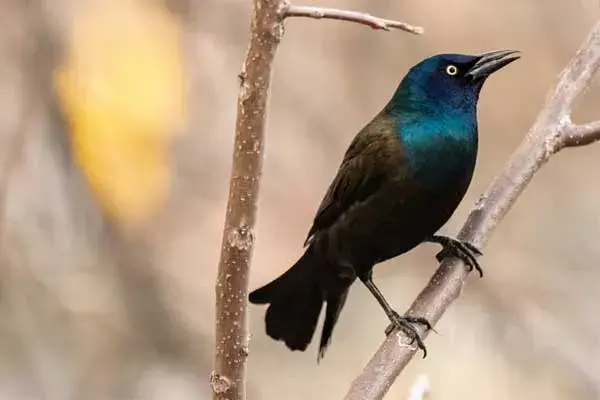
- Scientific Name: Quiscalus quiscula
- Lifespan: 17-22 years
- Wingspan: 14–18 in
- Length: 11-13 in
- Weight: 2.6–5.0 oz
Common grackles are one of the more widespread blackbirds with blue head colors. They are common in much of North America east of the Rocky Mountains, around woods, fields, farms, and urban areas.
With a wingspan of just 14 in and a weight of just 2.6 oz, common grackles are one of the smaller black birds that exist today.
These backyard songbirds have long, keel-shaped tails, dark beaks, and yellow eyes.
They are classified as songbirds because they have all the vocal equipment of a songbird, not because they have beautiful songs.
Their song is actually a high-pitched rising “readle-eak” screech that sounds like a rusty gate opening. Common grackles can also mimic the sounds of other birds and even humans.
Some scientists estimate a total population of over 73 million common grackles.
They are omnivores and feed on insects, minnows, frogs, eggs, berries, seeds, and grain.
A group of grackles is called a “plague”.
Common Starling
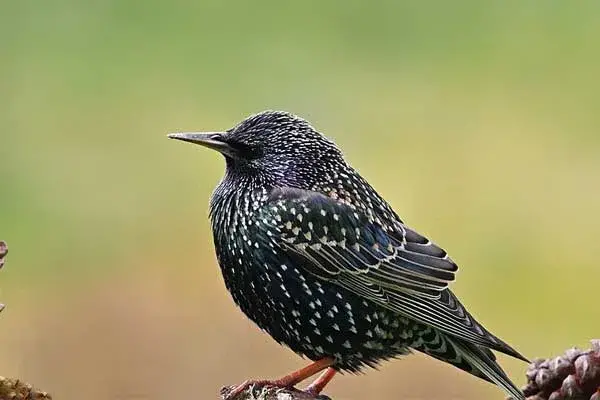
- Scientific Name: Sturnus vulgaris
- Lifespan: 2-3 years
- Wingspan: 12-17 in
- Length: 7.5–9.1 in
- Weight: 2-3.6 oz
Common starlings are small black birds that can be as little as 7.5 inches long and have a wingspan of just 12 in.
They have glossy black plumage with a metallic sheen, pink legs, and black beaks during winter that turn yellow in summer.
Common starlings are easy to recognize by white dots on their black plumage during winter, short tails, triangular wings, and long, pointed beaks.
They are also known as European starlings as they are native to Europe. They were introduced to other places, including North America, where common starlings are now designated invasive species.
In the United States, these birds are common around woodlands, parks, backyards, and urban areas of North Texas, where they can be seen year-round, especially in areas where people live.
- Read More: 25+ examples of birds from Northern Texas
Common starlings are very loud and social birds that can live in huge flocks; winter roosts can include from a few thousand to several million birds.
They are omnivores that mainly feed on berries, fruits, and seeds, but also insects, spiders, snails, earthworms, and other invertebrates.
Ring Ouzel

- Scientific Name: Turdus torquatus
- Lifespan: 2 years
- Wingspan: 14.9-16.5 in
- Length: 9.1–9.4 in
- Weight: 3.2–4.9 oz
Ring ouzels are small dark thrushes with distinctive pale crescents on their chests.
Males are mostly black and their chest crescent is bright white; females are browner and their crescent is duller. They have yellow beaks and grayish-brown legs.
You will recognize male ring ouzels by their “tri-rii, tri-rii” song that consists of two to four fluty notes, and their loud “tac-tac-tac” calls. They often sing at dawn.
These tiny black birds are migratory and can be found around the open highland habitats, including moorland, alpine meadows, rocky mountain sides, and conifer stands of Europe and Northern Africa.
Their main predators include tawny and long-eared owls, common buzzards, common kestrels, and Eurasian sparrowhawk.
Ring ouzels are omnivores and have a diet consisting of insects and berries.
Red-winged Blackbird
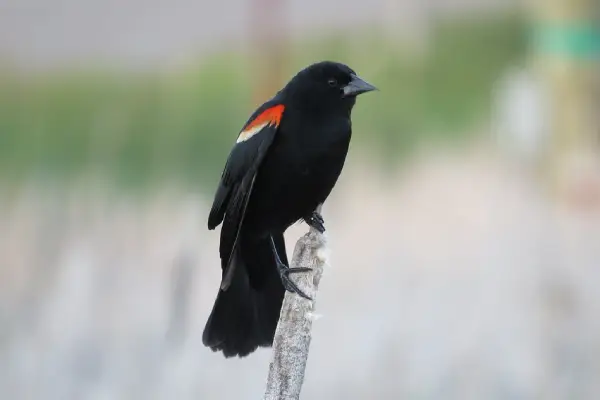
- Scientific Name: Agelaius phoeniceus
- Lifespan: 2 years in the wild
- Wingspan: 12-16 in
- Length: 6.7-9.4 in
- Weight: 1.46-2.3 oz
With a weight of just 1.46 oz and a length of 6.7 in, red-winged blackbirds are one of the smallest black birds.
Their scientific name “agelaios” means “gregarious,” while the “phoeniceus” means “crimson” or “red,” which perfectly describes these birds.
Males are easily identified by their completely black color and red epaulets that are edged in yellow. They often make red-shoulder displays and emit rich and scratchy “oak-a-lee” songs.
Females are smaller, streaky brown above, and paler below. They have a scolding chatter that sounds like “chit chit cheer teer teer teerr.”
Red-winged blackbirds are one of North America’s most abundant birds as during the nonbreeding season scientists often discover flocks varying from a few to over a million birds.
They are also very territorial and polygynous birds and a single male can have up to 10 different females making nests in his territory.
Females, on the other hand, will frequently mate with other males, and often lay eggs of mixed paternity. They will have a clutch of three to four pale blue-green eggs with dark streaks.
These blackbirds with red wings are omnivores and feed on insects, seeds, and grain.
There are over 20 subspecies of red-winged blackbirds.
Javan Myna
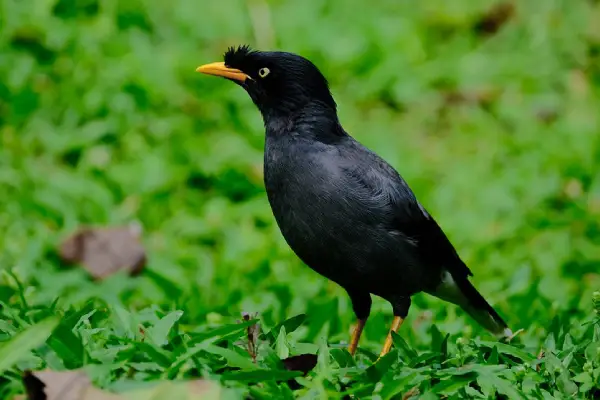
- Scientific Name: Acridotheres javanicus
- Lifespan: 5-10 years in the wild
- Wingspan: 15.7 in
- Length: 8.3–9.1 in
- Weight: 3.5 oz
Javan myna is a small crested bird that is native to Bali and Java, two big islands in Indonesia. It is also known as the white-vented myna and it is a member of the starling family, a group of small-sized passerine birds.
Javan myna is easy to recognize by its small size, black plumage, brownish-black wings, and a short crest on the forehead. This small black bird has lemon-yellow eyes and a yellow-orange beak, legs, and feet.
Javan myna ranges in length from 8.3 to 9.1 in and weighs 3.5 oz on average.
This bird is an omnivore and feeds on seeds, fruit, nectar, insects, and human waste. It is very bold and not afraid of humans.
Javan mynas are quite social birds that feed in groups. While others feed, one Javan myna will sit at a vantage point and keep watch for danger or trouble.
Brewer’s Blackbird
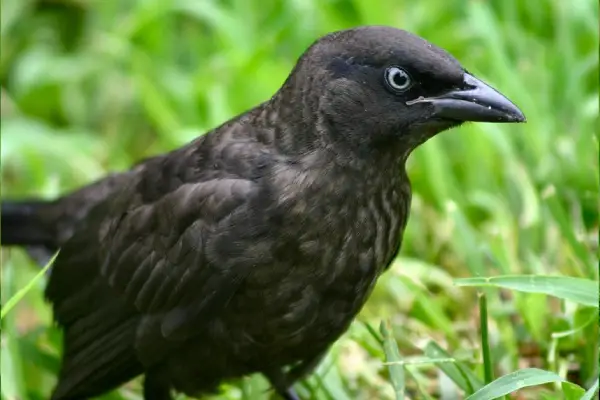
- Scientific Name: Euphagus cyanocephalus
- Lifespan: up to 12 years
- Wingspan: 15.5 in
- Length: 8–10.3 in
- Weight: 2.2 oz
Brewer’s blackbirds are common around open and semi-open areas, often near water, across central and western North America.
These small black birds that were named after the ornithologist Thomas Mayo Brewer have long legs, round heads, and long, thick-based bills.
Male Brewer’s blackbirds are black with iridescent purple heads and necks and have glossy bluish-green highlights on the rest of the body. Females are brownish-gray and don’t have the males’ iridescence.
They are common around bird feeders and can be also seen sitting perched up high on utility lines and tree tops looking for their next meal. They are omnivores and feed on seeds, insects, and some berries.
People often mistake Brewer’s blackbirds for common grackles – Brewer’s blackbirds have shorter tails.
Brewer’s blackbirds are protected in the US under the Migratory Bird Treaty Act, which means you can’t hunt them, except in some special cases.
Common Blackbird
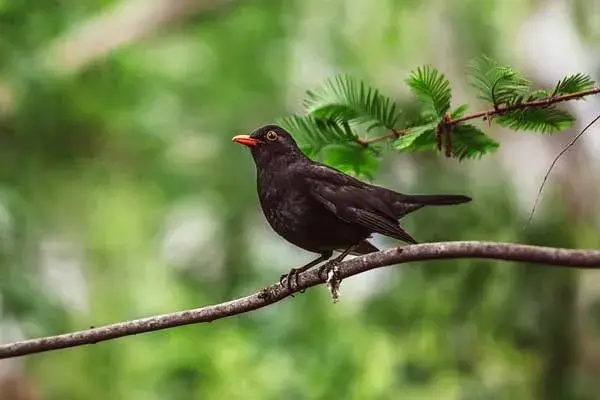
- Scientific Name: Turdus merula
- Lifespan: 4 years
- Wingspan: 13.4-15 in
- Length: 9.2-11.4 in
- Weight: 2.8-4.4 oz
Common blackbirds are small black birds commonly found in wooded habitats, parks, gardens, and farmlands of Europe, Asia, Africa, and Australia.
Males have fully black plumage, yellow eye-rings, bright golden-orange beaks, and rich melodious songs. Females are brown with reddish-brown breasts and dull yellowish-brown beaks.
Common blackbirds are omnivores that feed on worms, fruits, and seeds.
Scientists estimate that there are between 160 to 500 million of these birds in existence today.
Brown-headed Cowbird
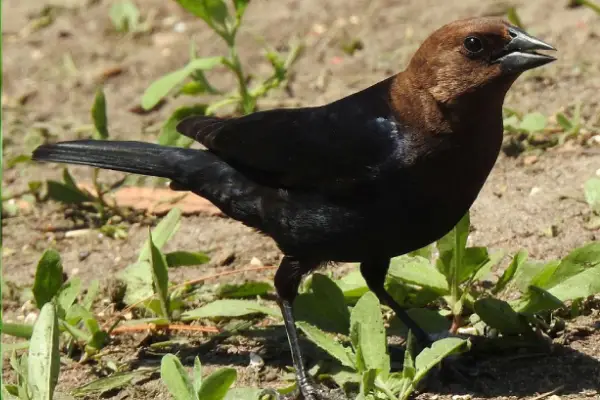
- Scientific Name: Molothrus ater
- Lifespan: up to 17 years
- Wingspan: 12-15 in
- Length: 6.3–8.7 in
- Weight: 1.1–2.1 oz
The brown-headed cowbird is a small blackbird with a stout bill and a short tail.
Males are iridescent black and have brown heads while females are slightly smaller and have dull grey plumage with pale throats and very fine streaking on their underparts.
Brown-headed cowbirds have a fascinating way of raising their young.
Instead of building nests, they lay their eggs in the nests of other small passerine birds (perching birds), while often kicking the host’s eggs out.
They do not discriminate and will lay eggs in nests of over 200 species of birds, including different birds of prey and even hummingbirds. The host will raise young cowbirds instead of their own young.
Some birds might realize this trickery and just puncture or throw the eggs out of the nest. Other birds, like the yellow warbler, will simply build a new nest over the top of the old one as they are too small to get the cowbird eggs out.
Brown-headed cowbird females can lay up to 36 eggs in a season and this egg-laying behavior is known as brood parasitism.
These birds are common around open woods, farmland, and stockyards of North America and can be often seen walking on the ground in pursuit of food.
Brown-headed cowbirds are omnivores and primarily feed on seeds and insects; they will also visit bird feeders.
During winter, they can be seen in flocks with other blackbirds; scientists discovered one such mixed roost in Kentucky that had over five million birds.
Bronzed Cowbird

- Scientific Name: Molothrus aeneus
- Lifespan: n/a
- Wingspan: 13 in
- Length: 7.3-7.9 in
- Weight: 2-2.4 oz
Bronzed cowbirds are small blackbirds commonly found around farmland, brush, feedlots, and open habitats of North and Central America.
Similar to brown-headed cowbirds, bronzed cowbirds lay eggs in the nests of other birds.
Male bronzed cowbirds are around 7.9 in long, weigh 2.4 oz, and have glossy black plumage. Their eyes are red in the breeding season.
Females are smaller, around 7.3 in long, have dull black plumage and brown underparts, and brown eyes.
Bronzed cowbirds are very social birds that can be seen foraging, resting, and roosting in flocks with over 100 birds.
They are omnivores and feed on seeds and insects, along with snails.
Tricolored Blackbird
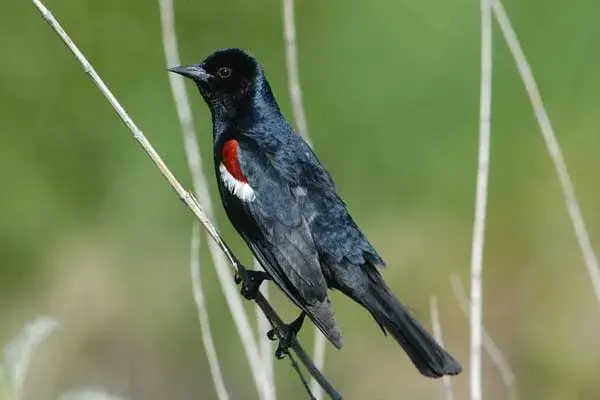
- Scientific Name: Agelaius tricolor
- Lifespan: 13 years
- Wingspan: 10.2-13 in
- Length: 7.1-9.4 in
- Weight: 1.4-2.6 oz
These small black birds with red and white shoulder patches are common on the Pacific coast of North America, from Northern California (USA) to upper Baja California (Mexico).
Tricolored blackbirds are social passerine birds found in the wetlands and grasslands of the Pacific states.
Males are easy to spot by their entirely black plumage with bright red shoulders and white-colored patches. Females are dark gray-brown and have streaked bellies and backs along with cream-colored eyebrows.
- Read More: List of birds that have eyebrows
Listen for their nasal “kip” and a sharp “check” call and the males’ garbled “on-ke-kaaangh” song.
Tricolored blackbirds form one of the largest colonies of any North American land bird, often including tens of thousands of individuals.
They are omnivores feeding on grasshoppers, seeds, beetles, weevils, caterpillars, and snails.
Tricolored blackbirds are listed as threatened species under the California Endangered Species Act and as endangered by the International Union for Conservation of Nature (IUCN).
Shiny Cowbird

- Scientific Name: Molothrus bonariensis
- Lifespan: n/a
- Wingspan: 11 in
- Length: 8.6 in
- Weight: 1.9-2.3 oz
Shiny cowbirds are small black birds found in the Caribbean and South America, and some parts of Southern Florida.
They are common around livestock, in semiopen and open grassy areas.
Shiny cowbird males have glossy violet-black plumage, greenish-blue wings and tails, and pointy blackish beaks. Females closely resemble brown-headed cowbirds with the main difference being their longer beaks and flatter heads.
Similar to other cowbird species, these birds are brood parasites that lay their eggs in other birds’ nests and rely on them to rear their chicks.
Male shiny cowbirds are very aggressive towards other birds and their kind – this includes behaviors like the “head-forwards threat”, “bill-tilt display”, physical breast-to-breast contacts, and chasings.
They are omnivores that feed on insects and seeds.
Read More: Examples of black and blue birds
Lark Bunting
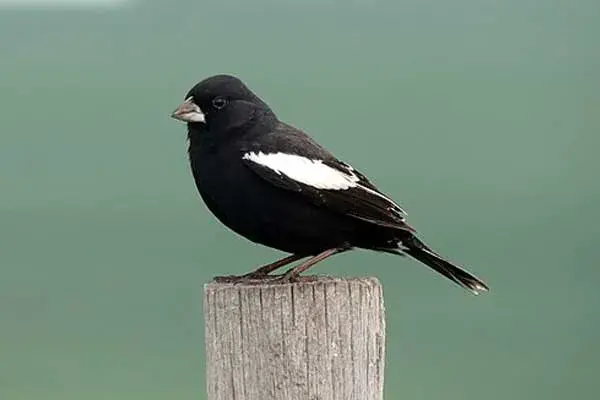
- Scientific Name: Calamospiza melanocorys
- Lifespan: n/a
- Wingspan: 9.8-11 in
- Length: 5.5-7.1 in
- Weight: 1.3-1.5 oz
Lark buntings are small black birds that are native to central and western USA. They are state birds of Colorado and one of many examples of birds found there.
With a weight of just over 1 oz, lark buntings are one of North America’s smallest black birds.
Common around grasslands, these birds are confusingly named, as they are neither lark nor buntings, but sparrows.
You will recognize breeding males by their black plumage with white wings. When the winter comes, they become grayish brown with small streaks of black and white. Their beaks have a pale blue-gray color.
Lark buntings hop along the ground when foraging; they walk or run when pursuing prey.
They are omnivores that feed in low areas, eating seeds, insects, and some fruits.
These small songbirds were selected as a state bird of Colorado due to their acrobatic courtship dance, melodic song, and being native there.
If you notice an open cup nest in a grassy area, pay close attention as it might be lark bunting’s.
Black Phoebe

- Scientific Name: Sayornis nigricans
- Lifespan: up to 8 years
- Wingspan: 10.5-11 in
- Length: 6.3 in
- Weight: 0.5-0.8 oz
Black phoebes are small flycatchers with predominantly black plumage and white parts on the bellies and undertail coverts. You will recognize them by their characteristic “tail-wagging” motion where they lower the tails and fan out the tails’ feathers.
Sexes look similar and have a repeated “tee-hee, tee ho” song.
Black phoebes weigh as little as half an ounce and have a wingspan of just 10.5 inches.
They are common across the Western USA and can be found in open areas near lakes, streams, and ponds, as well as agricultural areas and city parks.
Black phoebes are carnivores that mostly feed on insects, but might occasionally catch fish.
They will use mud to build their cup-shaped nests, placing them often against walls, overhangs, and bridges.
Bobolink

- Scientific Name: Dolichonyx oryzivorus
- Lifespan: 2-9 years in the wild
- Wingspan: 10.6 in
- Length: 5.9-8.3 in
- Weight: 1-2 oz
Bobolinks are small songbirds that are easy to recognize by their black color, flat heads, and short necks and tails.
Male bobolinks are mostly black with buff-yellow backs of their heads (on the napes), white scapulars, lower backs, and rumps. Females are mostly light brown with black streaks on the back and flanks.
They weigh from one to two ounces and have a wingspan of around 10.6 in.
People often call them “rice birds” for their tendency to feed on cultivated grains during winter. Bobolinks are omnivores whose diet mostly consists of seeds and insects.
These long-distance migrants travel over 12,000 miles to and from central South America each year – during a lifetime, one bobolink may travel the same distance as four or five laps around the planet.
Bobolinks are polygynous but also often polyandrous. This means that each clutch of eggs laid by a single female may have multiple fathers.
A group of bobolinks is known as a “chain”.
Read More: Examples of incredible black birds that have yellow heads
Dark-eyed Junco
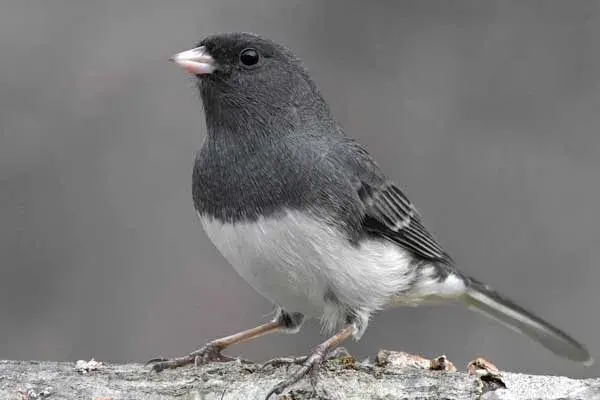
- Scientific Name: Junco hyemalis
- Lifespan: 3-11 years
- Wingspan: 7.1-9.8 in
- Length: 5.1-6.9 in
- Weight: 0.63-1.06 oz
Dark-eyed juncos are a group of small New World sparrows. These tiny black birds can weigh less than an ounce and be as little as 5 inches in length.
Dark-eyed juncos are easy to recognize by their rounded heads, short beaks, and fairly long tails. They are black above, their head is dark, their bellies are white, and their beaks are pale.
Dark-eyed juncos are one of the most common birds of North America that can be seen around woodlands, brushy fields, parks, and thickets.
They often forage while hopping and running on the ground and might even scratch the ground/snow with their feet in pursuit of food.
Dark-eyed juncos are nicknamed “snowbirds” because they’re commonly sighted in winter throughout North America.
They are omnivores that mostly feed on seeds, and some insects in summer.
There are 15 subspecies of dark-eyed juncos.
Read More: Examples of tiny birds that have white plumage
Pied Bush Chat
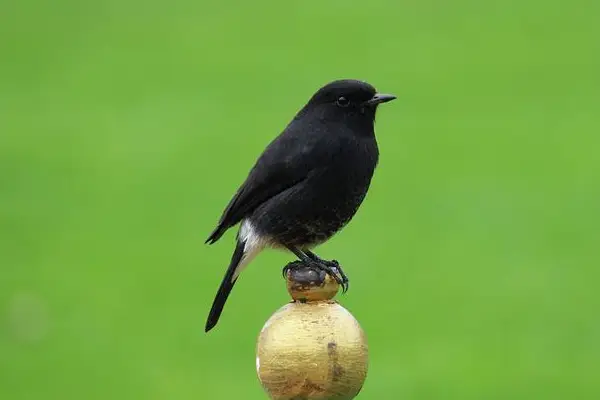
- Scientific Name: Saxicola caprata
- Lifespan: n/a
- Wingspan: 8.2-9 in
- Length: 5.1 in
- Weight: 0.45-0.6 oz
Pied bush chats are small black passerine birds that weigh less than half an ounce and are just over 5 inches long. They have a wingspan ranging from 8 to 9 inches and are one of the smallest black birds.
They are common in the countryside, open scrubs, and grasslands of Asia, sitting perched at the top of short thorn trees or other shrubs, looking for insects.
Males have black plumage with white shoulder and vent patches while the females are mostly dark brownish and have reddish-brown rumps and underparts. They have dark brown eyes and black beaks and legs.
These small black birds are occasionally “victims” of brood parasitism – common cuckoos might visit bush chats’ nests and remove an egg before quickly laying their own.
There are over 16 subspecies of pied bush chats. Their calls include rising “whee” and a hard “chruk.”
Read More: Examples of 20 small blue birds
Summary
This concludes our list of small black birds.
Examples of small black-colored birds include several types of blackbirds, mynas, starlings, and many others.
Hopefully next time you see these birds, you will recognize any of them with ease!
And if you enjoyed our article, here’s another popular read on birds: 25+ examples of the biggest black birds and 25+ examples of stunning birds of East Tennessee